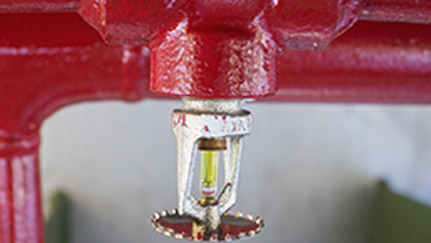Inspect, test and maintain fire pumps to NFPA standards for effective response in an emergency.
Subscribe to our newsletter for timely content in your inbox

A fire can be devastating. It can destroy property, interrupt business and cause injury or even death. This is what motivates us to take a proactive view of fire protection and take the necessary steps to help prevent or minimize losses caused by fire.
Installing a water-based fire protection system is an effective means to help suppress accidental fires and reduce fire losses. Systems range from sprinkler to standpipe and hose systems.
At the heart of any system is the fire pump, which supplies water at the required flow level and pressure.
The fire pump must be inspected, tested and maintained regularly to ensure fast, effective response in a fire emergency. System failure for any reason could lead to potentially catastrophic losses.
The responsibility for properly maintaining a water-based fire protection system lies with the owners or occupants of the property. These persons should be familiar with the inspection, testing and minimum maintenance intervals set out in National Fire Protection Association (NFPA) 25 for fire pumps.
| Item | Activity | Frequency | Reference |
|---|---|---|---|
| Pump house, heating ventilating louvers | Inspection | Weekly | 8.2.2(1) |
| Fire pump system | Inspection | Weekly | 8.2.2(2) |
| No-flow condition | Test | Weekly | 8.3.1 |
| Flow condition | Test | Annually | 8.3.3.1 |
| Hydraulic | Maintenance | Annually | 8.5 |
| Mechanical transmission | Maintenance | Annually | 8.5 |
| Electrical system | Maintenance | Varies | 8.5 |
| Controller, various components | Maintenance | Varies | 8.5 |
| Motor | Maintenance | Annually | 8.5 |
| Diesel engine system, various components | Maintenance | Varies | 8.5 |
Always consult a qualified professional to perform the initial fire pump inspections, tests and maintenance tasks. Follow-up testing may be performed by your in-house maintenance personnel, if they are properly trained by qualified personnel.
Inspecting your fire pump is among the easiest and quickest ways to identify a problem, such as a leaky pipe. Weekly inspections include, but are not limited to:
The annual pump test is more complicated and should be performed by a qualified fire pump-testing professional
Preventive maintenance is the key to a successful maintenance program and a properly functioning fire protection system. Through preventive maintenance, every component of your fire protection system is inspected, repaired and maintained in such a way that helps prevent failures.
Always maintain written documentation on all work performed on the pump, driver, controller and auxiliary equipment. Written records verify that a proper maintenance schedule has been followed and help shed light on any problem areas.
It’s your business, and a loss due to a malfunctioning fire pump can be catastrophic. Nobody knows when a fire will happen, but you can take measures to help reduce the potential damage, including: